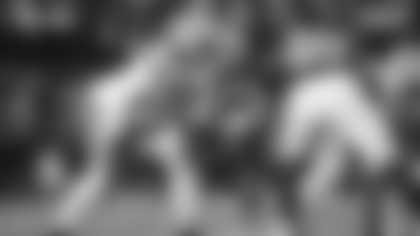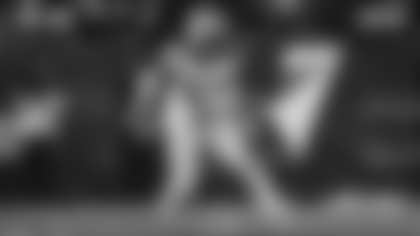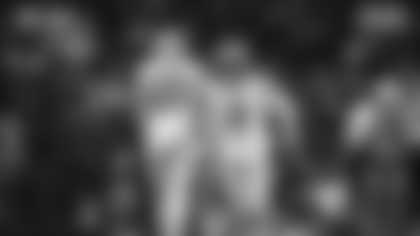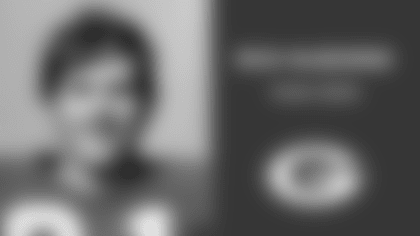Hi Lee. You told John in Lakewood, Calif. that Vince Lombardi's Packers only lost to the L.A. Rams one time, in 1965. Didn't they beat the Pack in 1967, two weeks before the playoff game Green Bay won 28-7? I believe it was a blocked Donny Anderson punt in the final seconds that set up the win. - Bret (Casa Grande, Ariz.)
Bret, you are exactly right. The Packers did lose to the Rams in the Los Angeles Memorial Coliseum on December 9, 1967, by a score of 27-24 -- just two weeks prior to defeating the Rams, 28-7, in a Western Conference playoff December 23, 1967. The playoff victory, of course, projected the Packers into the NFL Championship Game eight days later (December 31, 1967), which became the legendary "Ice Bowl," won by Bart Starr's last minute quarterback sneak.
Lee, I can remember a game back in the '60s at Wrigley Field in Chicago. The game was close and the Packers had to punt from deep in their territory. I can't remember if it was entering halftime or the end of the game. Apparently the Packers punted the ball and Chicago got possession and called for a "free kick." Mac Percival, the place kicker for Chicago, was good on the field goal attempt. Was that for the half or was that at the end of the game? How many other Packer games have involved "free kicks?" Thanks. - James (New York City)
James, the situation you describe actually occurred at Lambeau Field -- on November 3, 1968. With just 38 seconds remaining in the game and the score tied 10-10, the Bears' Cecil Turner, back to receive a punt from left-footed Donny Anderson, signaled for a fair catch and fielded the football at the Chicago 43 yard line.
The Bears immediately made known their intentions to Referee Pat Haggerty and lined up in kick formation, whereupon their specialist, Mac Percival, sent the free kick over the crossbar to seal a 13-10 Bears victory.
As far as can be determined, it was only the second free kick situation in which the Packers have been involved over their history -- both against the Bears. The first came when Vince Lombardi made such a call in a game against the Midway Monsters -- also in Lambeau Field -- on September 13, 1964.
On that occasion, with only seconds left in the first half, Elijah Pitts, back to receive a Chicago punt from Bobby Joe Green, signaled for a fair catch as he fielded the football at the Packers' 48 yard line.
Lombardi had informed Referee Norm Schachter that the Packers would be attempting a fair catch kick on what would be the final play of the first half -- and the Green and Gold promptly lined up.
Paul Hornung, once again the Packers' placekicker after sitting out a one-year suspension in 1963, advanced to kick the ball out of Bart Starr's hold and it sailed through the uprights, padding the Packers' lead to 17-3 as the first half ended.
Hornung's 52-yard success tied the team's existing field goal distance record, set by Ted Fritsch against the New York Yanks October 19, 1950. The Packers went on to defeat the Bears, 23-12.
The free kick, by definition, means that the defending team must be 10 yards removed from the scrimmage line of the kicking team and cannot "rush" the kick, which thus, as the name implies, is a "free" kick.
Hey Lee, I have been watching the Pack for 47 years and listened on the radio with my father. My favorite player was Jim Taylor. I recall a game that he and Paul Horning each gained 100 yards. How many times has this happened with the Packers that two players gained 100 yards in the same game? Thank you for all the information. I was born in Rhinelander and sure miss the Packer spirit. - Bill (Holly Springs, Miss.)
Bill, I believe the game you are referring to was the 1965 NFL Championship Game, played in Lambeau Field on January 2, 1966. Actually, Paul Hornung rushed for 105 yards on that occasion (on 18 attempts) but Taylor fell just short of the century mark, gaining 96 yards on 27 attempts.
Such a feat -- 100-yard games by a brace of running backs -- has been recorded three times in Packers regular season history. Once by John Brockington (142 yards on 22 attempts) and MacArthur Lane (101 yards on 19 attempts) against the Bears at Chicago on December 16, 1973, and twice by Eddie Lee Ivery and Gerry Ellis.
Ivery and Ellis turned the trick for the first time on November 23, 1980, at Minnesota, Ivery gaining 145 yards on 24 attempts, and Ellis, 101 yards on 15 attempts. They repeated that scenario against the Tampa Bay Buccaneers in Lambeau Field's "Snow Bowl" December 1, 1985, Ivery rushing for 109 yards on 12 attempts and Ellis for 101 yards on 9 carries.
Hi Lee. Why did the Packers begin to play in Milwaukee at County Stadium? I have heard many explanations, some having to do with money and others with assisting in the signing of Paul Hornung. Please clear this up for me. - Christopher (Aurora, Ill.)
For financial reasons, mainly. At the time (1953), County Stadium had a substantially larger capacity than Green Bay's City Stadium -- 45,000 -- to 'Old' City Stadium's 24,800. "New" City Stadium, which opened in 1957, also had a smaller initial capacity (32,150).
Beyond that, I do not believe that Paul Hornung's contract had anything specifically to do with the Packers playing games at County Stadium. He did not join the Packers until 1957, four years after the Packers began to play games in County Stadium.
Hello, Lee. I'm writing to ask you about the team colors and funding from the start. When did the green and gold start and how? Also, we all know the Packers are a "town team" but how did we afford this right away? When did we start to seriously get money to bring good players to Green Bay right from the start? Thanks a lot. - KC Hohn (Bowler, Wisc.)
KC, to attempt to answer your questions in the order they were asked: The green and gold colors were solidified into the uniform's color scheme in 1950 by then new Head Coach Gene Ronzani, who did so while saying, in explanation, "We are the Green Bay Packers." More info on the Packers' uniform history can be found on Packers.com by clicking here.
As far as the team's early finances are concerned, the fledgling Packers actually had to forfeit their league franchise at the end of the 1921 season, their first in what was to become the NFL. Primarily through the efforts of Curly Lambeau, the team was able to buy the franchise back but the financial problems continued until late in the '22 season when Andrew Turnbull, publisher of the Green Bay Press-Gazette, lobbied town businessmen behind the team and formed the Green Bay Football Corporation.
Subsequently, the team launched its first stock issue -- at $5 a share -- and the franchise was en route to becoming perhaps the greatest story in the history of professional sports. For more on the Packers stockholder history, click here.
The Packers, by the way, signed their first "name" college player in 1921 -- a tackle named Howard "Cub" Buck from the University of Wisconsin. He was followed in 1924 by the legendary Verne Lewellen, an all-purpose running back from Nebraska who eventually became the team's general manager.
Hi Lee!!! I enjoy reading your columns. With all the old films, videotapes, etc...the Packers and NFL Films must have, do you ever think that there will ever be a series of videos or DVD's that are kind of "best ofs?" Many of us have our favorite player from the '60s. How about a best of Nitschke, Starr, Hornung, Taylor, etc...Any chance that will ever happen???? - Mark (Whitewater, Wisc.)
As much as I would like to see it -- and I think it's a great idea -- I would doubt that such a series will come to pass. There are, however, some films of historic teams and games produced under the ESPN Classic banner. Among them, I believe, one on the "Ice Bowl." You should be able to gain additional information by calling ESPN (856)-222-3500.
Hi Lee! I would like to ask for your insight regarding Packers history. It has been well established that Lisle Blackburn and Ray "Scooter" McLean did not have stellar careers as head coaches of the Packers. Yet why are these two men overlooked for their drafting skills as some of the players that were acquired in the latter part of the 1950s went on to form the nucleus of the teams that won the five championships of the Lombardi Era. I look forward to reading your position on this matter. Thank you!!! - Marin (West Lawn, Penn.)
Marin, it is true that some of the premier players in Packers history -- Paul Hornung, Ron and Jerry Kramer, Jim Taylor and Ray Nitschke, among others -- were drafted during the head coaching tenures of Liz Blackbourn (1954-57) and Ray McLean (1958).
However, the impression remains that the club's drafting success in those years was traceable in large measure to the scouting skills of the late Jack Vainisi, the team's primary talent scout during that period.
Vainisi, a Notre Dame alumnus, was known to have lobbied extensively for the selection of Hornung, for example, going into the '57 draft.
From my understanding, some of the stadiums the Packers have played their home games in where Borchardt Field, State Fair Park, Marquette Stadium, City Stadium and now Lambeau Field. Where can I go to find pictures or photos of these fields, parks or stadiums and get some history of each place? Thank you. - Steven M. Seston (Menomonee Falls, Wisc.)
Steven, it may have been intentional, but you left out Milwaukee County Stadium out of your list of stadiums where the Packers have played over the course of their history.
They also played at Green Bay's Hagemeister Park in 1919-22, their first four seasons, and at the city's Bellevue Park in 1923-24 before moving into the original City Stadium in 1925.
As far as photos are concerned, the only one available -- aside from pictures of the current and renovated Lambeau Field, which are available at the Packers Pro Shop in "Lambeau" -- would be a 1941 photo of "old" City Stadium, which can be obtained at "Packer City Antiques" in Green Bay (1920 Marlee Lane, telephone 910-490-1095).
For more on the Packers' stadium history, click here.
Lee, when was the first year of The Packers Yearbook? - Terry (Sheboygan, Wisc.)
Terry, the Packers Yearbook was published for the first time in 1960, Vince Lombardi's second year in Green Bay. It was founded by Art Daley, then sports editor of the Green Bay Press-Gazette, in conjunction with Jack Yuenger, then the newspaper's advertising director.
If I may interject a personal note, I have had the privilege of writing articles for the Yearbook annually over its 45-year history.
Continuing an association with the team that is more than 55 years old, Lee Remmel was named the first official Team Historian of the Green Bay Packers in February 2004. The former *Green Bay Press-Gazette reporter and Packers public relations director, Remmel will write regular columns for Packers.com as part of his new assignment.
In addition to those articles, Remmel will answer fan questions in a monthly Q&A column. To submit a question to Remmel, click here. *














